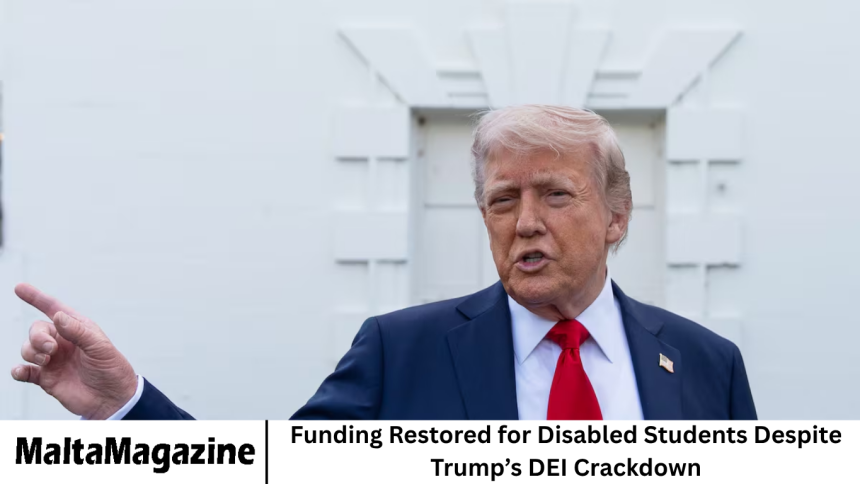Students with both hearing and vision loss across the United States recently received a moment of relief. After weeks of fear and uncertainty, the government decided to restore critical funding that supports their education. The reversal came after strong backlash from families, educators.
And disability advocates who argued that cutting the funds would hurt some of the nation’s most vulnerable children. However, this story is not just about education—it’s about politics too. The funding cuts and their quick reversal happened during a time when former President.
Donald Trump’s administration is working to reduce or remove programs related to Diversity, Equity, and Inclusion (DEI). Many see this as part of a larger push to reshape how federal programs deal with issues of fairness, bias, and equality.
More Read: The 9/11 Origins Behind Trump’s Battle Against ‘Antifa’
What Happened
Earlier this year, several education programs that help students with both hearing and vision loss were told their federal funding would be stopped. These programs existed in several states and had been running for decades.
They help children who are deaf-blind get the special support they need to learn, communicate, and live more independent lives. The total funding wasn’t very large—about one million dollars spread across a few programs—but the impact was enormous.
For the children involved, even small cuts could mean losing access to trained teachers, special learning tools, and family support services. The reason given for the funding cuts surprised many people. According to reports, some applications for these grants had included words like “inequities,” “racism,” and “bias.”
Officials said this language conflicted with the government’s new focus on “merit, fairness, and excellence.” In other words, they viewed the language as part of DEI programs, which the Trump administration has been trying to remove from many areas of government.
When news spread about the decision, parents and advocacy groups quickly spoke out. They warned that losing this funding would cause serious harm to students who already face huge challenges in the classroom.
The Backlash and Reversal
The outcry worked. After several weeks of public criticism, the Department of Education decided to restore the funding. Officials announced that the money would be rerouted through another organization—the National Center on DeafBlindness—so that the programs could continue for at least one more year.
While families were relieved, they also knew the solution was temporary. The funding was restored, but only for one year, and no one knows what will happen after that. For many educators, this feels like a warning that future funding could again be at risk.
Why It Matters
For the average person, this might sound like a small policy change, but for students who are deaf-blind, it’s life-changing. Children who cannot hear or see well need specialized education programs. These programs teach them how to communicate, read, move safely, and live independently.
Without the proper support, these children often struggle to participate in school or even communicate with others. The programs that lost funding are vital for their development and future success.
When funding disappears, it’s not just about losing money—it’s about losing opportunities for education, connection, and dignity. Families depend on these services, and sudden funding cuts can disrupt their entire lives.
The Political Angle: Trump’s Anti-DEI Push
This situation cannot be separated from the larger political debate over DEI programs. The Trump administration has made it clear that it wants to remove what it calls “divisive concepts” from schools and government programs.
This includes efforts that highlight racial inequity, bias, or systemic discrimination. Supporters of this policy argue that DEI initiatives unfairly favor certain groups and divide Americans instead of uniting them.
Critics, however, say that cutting DEI programs—especially those helping marginalized groups—hurts the people who need help the most. They argue that “merit and fairness” should not mean ignoring inequality or pretending that bias doesn’t exist.
In this case, the affected programs weren’t focused on race at all. They served children with disabilities. But because the grant applications used language common in DEI programs, they became targets of this broader political campaign.
This shows how deeply politics can influence education, even in areas that seem far removed from partisan issues.
The Human Impact
Behind every funding battle are real people. Families of deaf-blind children rely on these programs for guidance, training, and emotional support. Many parents describe feeling isolated and unsure how to help their children communicate.
Programs supported by federal funding provide teachers trained in tactile communication methods, interpreters, and specialized equipment. They also organize family events where parents can meet others facing similar challenges.
When the funding was cut, some of these events were immediately cancelled, leaving families disappointed and anxious. One mother explained that these programs were her lifeline. Without them, she would have no way to learn how to communicate with her child.
For many families, losing this support feels like being abandoned by the system that’s supposed to protect them.
Educators Speak Out
Teachers and program coordinators also raised their voices. They explained that deaf-blindness is a “low-incidence” disability—meaning not many students have it, but those who do need highly specialized care.
That’s why national funding is crucial; local schools often don’t have the resources to serve these students properly. Educators argued that these programs are not about politics—they’re about giving children the basic right to learn and grow.
They called the decision to cut funding “cruel and unnecessary.” Many also said that removing DEI language from grant applications would only make it harder to address real inequalities faced by disabled students.
A Temporary Fix, Not a Solution
The restored funding is a short-term win, but it doesn’t solve the problem permanently. The new arrangement only guarantees money for one year, and there’s no assurance that it will continue.
Advocates worry that the same thing could happen again next year—or that other disability programs could face similar scrutiny. The uncertainty makes it hard for schools to plan or hire staff, and families are left wondering what will happen next.
Experts say the situation shows why stable, long-term funding is so important for programs that serve disabled children. These children need consistency, not political back-and-forth.
A Lesson in Advocacy
If there’s a silver lining, it’s that public pressure worked. Journalists, advocacy groups, and families came together to speak out, and the government listened. This case shows how media attention and collective action can make a real difference.
Many parents say they learned the importance of raising their voices and reaching out to lawmakers. The message was clear: when enough people stand up for what’s right, even powerful institutions can change course.
What Comes Next
Looking ahead, several big questions remain.
- Will the Department of Education renew long-term grants for these programs?
- Will other disability programs face cuts for using DEI-related language?
- Will future applications have to remove words like “inequity” and “bias” to stay eligible for funding?
These questions highlight a bigger issue: how should the government balance fairness, merit, and equality in education? Should programs that address inequality be considered “divisive,” or should they be viewed as essential?
The answers will shape the future not just for deaf-blind students, but for millions of others who depend on inclusive educational policies.
The Broader Picture
The fight over this funding is part of a larger national debate. Across the country, schools and universities are being asked to change or remove DEI programs. Some states have passed laws limiting how race and inequality can be discussed in classrooms.
Supporters of DEI say that these programs create a fairer, more understanding society. Opponents argue they go too far and create new forms of discrimination.
In the middle of this debate are people like the deaf-blind students affected by these cuts—children who only want a fair chance to learn and thrive. Their situation shows that when politics enters education, the ones who suffer most are often the students who need help the most.
The Importance of Stability
For children with disabilities, stability is everything. Their learning often depends on long-term support and consistent teaching methods. Frequent changes in funding or policy can undo years of progress.
Families and educators are now calling on the government to commit to multi-year funding plans that can’t be easily overturned. They also want clearer communication from federal officials about what kind of language or goals are acceptable in grant applications.
Many advocates believe the key is to keep politics out of disability education and focus on what really matters—helping children reach their potential.
Moving Forward
The story of the restored funding sends a powerful message. It shows that advocacy matters, but it also reminds us how fragile progress can be. The fight for equality and inclusion—whether under the name DEI or simply fairness—will continue as long as there are students who risk being left behind.
Educators and families hope that this situation will inspire lawmakers to protect funding for all special education programs, no matter the political climate. They also hope that public awareness will grow so that society continues to support children with disabilities in every way possible.
Frequently Asked Question
Who are the students affected by this issue?
They are children and young adults who are both deaf and blind. These students need special educational programs to help them learn communication, movement, and daily living skills.
Why was the funding cut in the first place?
The funding was cut because the government said some grant applications used DEI-related terms like “racism” and “inequities,” which conflicted with its new policies focused on “merit and fairness.”
How was the funding restored?
After public outcry, the Department of Education decided to send the funds through another organization, allowing the programs to continue for one more year.
Is this a permanent solution?
No, it’s temporary. The funding is only guaranteed for one year, and there’s no certainty about what will happen after that.
How did families and teachers react?
They were relieved but still worried. Many said they were glad the money came back but feared it could disappear again in the future.
What does DEI mean in this context?
DEI stands for Diversity, Equity, and Inclusion. It refers to efforts to make education and workplaces fairer for everyone, especially those who face discrimination or disadvantage.
What can be done to protect these programs in the future?
Advocates suggest creating long-term funding laws, improving communication between government and educators, and keeping politics out of disability education.
Conclusion
The decision to restore funding for students with hearing and vision loss is a victory, but a cautious one. It proves that public voices can make a difference, yet it also reveals how easily vital programs can be caught in political battles.
Children with disabilities should never have to pay the price for political debates. Their right to education, communication, and dignity must come first. The hope now is that this temporary fix becomes a permanent commitment—and that no child with a disability ever faces such uncertainty again.








